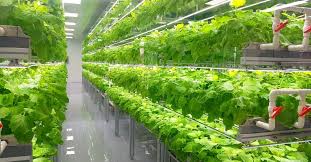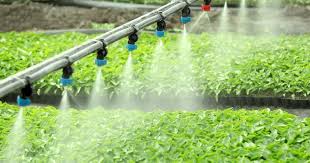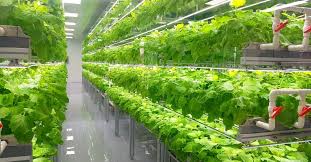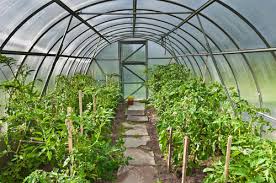Controlled Environment Agriculture (CEA) is a method of cultivating plants in a fully regulated environment. It is also known as ‘vertical farming or indoor farming.’ In this type of cultivation, all the plant’s needs are met by artificially providing them with water, nutrients, and light using hydroponic, aquaponic, and aeroponic techniques.
CEA has proven to reduce some of the challenges faced in conventional farming. For example, it greatly reduces water consumption depending on the farm setup. In fact, some vertical farms use 70% to 95% less water than what’s typically required in traditional outdoor farms.
In addition to optimal water usage, CEA protects plants from adverse weather conditions and helps maximize the use of space for cultivation.
Importance and Benefits of CEA
1. Year-Round Production: CEA allows farmers to grow crops all year, regardless of external climate conditions. This means a steady supply of fresh produce even during off-seasons, reducing the need for imports and ensuring food security.
2. Efficient Use of Resources: CEA systems are highly resource-efficient, using less water and nutrients compared to traditional farming. By recirculating water and carefully monitoring nutrient levels, CEA reduces waste and maximizes the use of inputs, making it an environmentally friendly option.
3. Reduced Pesticide Use: CEA minimizes the need for chemical pesticides because it isolates crops from outdoor pests and diseases. This leads to healthier, pesticide-free produce that is better for both consumers and the environment.
4. Space Optimization: In CEA, vertical farming techniques can be used to grow crops in layers, maximizing production within limited spaces. This is particularly beneficial in urban areas where land is scarce, enabling local food production close to consumers.
5. Improved Crop Quality and Yield: By controlling variables like temperature, humidity, light, and nutrients, CEA systems can optimize growing conditions for specific crops, resulting in higher yields and superior quality produce. This level of precision also enables farmers to grow specialty crops that might not thrive in natural outdoor environments.
6. Climate Change Resilience: CEA provides a reliable food production method that is less vulnerable to climate change-related issues like droughts, floods, and unpredictable weather patterns. This stability makes it a vital tool for maintaining consistent food supplies in the face of climate challenges.
Types of Controlled Environment Agriculture Systems

1. Greenhouses: Greenhouses are enclosed structures that allow sunlight to enter while protecting crops from extreme weather. They can be equipped with heating, cooling, and ventilation systems to control the environment, making them ideal for producing a wide variety of crops in different climates.
2. Indoor Vertical Farms: Vertical farms are fully enclosed and often located in urban areas. They use stacked layers to grow crops, maximizing space. These systems rely on artificial lighting and automated controls for temperature, humidity, and nutrients, making them well-suited for leafy greens, herbs, and microgreens.
3. Hydroponic Systems: Hydroponics involves growing plants without soil, using a nutrient-rich water solution to deliver essential nutrients directly to the roots. This method conserves water and allows for precise control over nutrient levels, making it highly efficient and productive.
4. Aeroponic Systems: In aeroponics, plant roots are suspended in the air and misted with a nutrient solution. This technique uses minimal water and enables high levels of oxygenation at the roots, leading to faster growth rates. Aeroponics is often used for leafy greens and herbs.
5. Aquaponic Systems: Aquaponics combines hydroponics with aquaculture (raising fish) in a symbiotic system. Fish waste provides nutrients for plants, which, in turn, help filter and clean the water for the fish. This closed-loop system is sustainable and highly efficient, producing both plants and fish.
6. Controlled Container Farms: Container farms utilize repurposed shipping containers outfitted with vertical farming systems, artificial lighting, and climate controls. They are portable and modular, making them an innovative solution for urban agriculture and remote locations.
Key Components of CEA Systems
1. Lighting Systems: In CEA, artificial lighting (such as LED lights) is used to supplement or replace sunlight, providing the specific wavelengths that plants need for photosynthesis. Different light spectrums are adjusted to match the plant’s growth stages, promoting optimal development and yield.
2. Heating and Cooling: Temperature control is essential for maintaining the optimal environment for plant growth. Heating systems ensure crops are kept warm in cooler months, while cooling systems, such as fans and air conditioning, prevent overheating during warmer months or when artificial lighting generates heat.
3. Ventilation and Airflow: Proper airflow is crucial for regulating humidity and CO₂ levels and preventing mold and fungal growth. Ventilation systems also help distribute heat and moisture evenly throughout the growing area, ensuring plants receive consistent air quality.
4. Nutrient Delivery Systems: Nutrient solutions are delivered to plants via various methods, depending on the CEA system. In hydroponics and aeroponics, for example, nutrients are dissolved in water, allowing precise control over the nutrient content. This targeted delivery ensures plants get exactly what they need for healthy growth.
5. Water Management Systems: Water recirculation and filtration systems reduce water use by collecting runoff and reusing it, which conserves resources and minimizes waste. Water quality is carefully monitored to maintain the proper balance of nutrients and pH levels.
6. Growth Media: While soil is not used in most CEA systems, alternative growth media like coco coir, peat moss, or rock wool provide root support and retain moisture. These media are often chosen for their ability to hold nutrients and allow for excellent aeration.
Environmental Controls in CEA
1. Temperature Control: Temperature is one of the most critical factors for plant growth, affecting photosynthesis and respiration rates. In CEA systems, sensors continuously monitor and adjust temperature to maintain an ideal range for the specific crops being grown.
2. Humidity Control: Managing humidity levels is essential to prevent mold, mildew, and other diseases. Humidity control systems adjust moisture levels to maintain an optimal environment, depending on the crop’s growth stage and type. Lower humidity is often required for mature plants, while seedlings may thrive in higher humidity.
3. CO₂ Enrichment: Plants use CO₂ during photosynthesis, so maintaining the right concentration can improve growth and yield. In some CEA systems, CO₂ is supplemented to ensure plants have an adequate supply, particularly in fully enclosed systems where natural CO₂ may be limited.
4. Light Control: Artificial lighting systems are carefully timed to simulate natural daylight cycles. Grow lights can be set to mimic different day lengths and light intensities, supporting each stage of plant growth from vegetative growth to flowering and fruiting.
5. pH and Nutrient Monitoring: pH and nutrient levels are continuously monitored to ensure plants receive a balanced nutrient solution. Automatic pH adjusters and nutrient dosing systems help maintain optimal conditions for plant health, reducing the risk of nutrient deficiencies or toxicities.
6. Data Collection and Automation: Sensors collect real-time data on environmental factors such as temperature, humidity, and CO₂ levels. This data is used to automate adjustments, ensuring consistent growing conditions and reducing the need for manual intervention. Automation also enhances precision, allowing CEA systems to operate more efficiently.
Lighting and Energy Efficiency in CEA
1. Artificial Lighting: In CEA systems, artificial lighting especially LED lighting is commonly used to replace or supplement natural light. LED lights are highly energy-efficient, generating low heat and delivering precise light wavelengths that plants need for photosynthesis. Different growth stages benefit from different light spectrums, such as blue light for vegetative growth and red light for flowering.
2. Light Intensity and Duration: Light intensity and the duration of exposure are optimized to maximize plant growth. LED lights can be programmed to mimic natural light cycles, ensuring plants receive a consistent and ideal light pattern. This precise control can increase crop yield and improve quality.
3. Energy Efficiency: LED lights consume significantly less energy than other lighting options like fluorescent or incandescent lights. They also last longer, reducing the need for replacements and lowering overall costs. Additionally, the minimal heat output from LEDs reduces the need for cooling systems, contributing further to energy savings.
4. Solar Panels and Renewable Energy: To offset energy use, many CEA facilities integrate renewable energy sources like solar panels. Solar power provides a sustainable way to reduce the carbon footprint of indoor farming operations, especially for large-scale facilities with high energy needs.
5. Smart Energy Management: Automated energy management systems track and control lighting schedules and power consumption. These systems can adjust light intensity and duration based on crop needs, thereby improving energy efficiency and reducing costs.
Read Also: 17 Medicinal Health Benefits Of Lotus Seed (Nelumbo nucifera)
Water Management and Irrigation in CEA

1. Recirculating Systems: In hydroponic and aquaponic systems, water is recirculated to minimize waste. Water is collected and filtered after each use, then returned to the plants with nutrients replenished as needed. This approach uses up to 90% less water than traditional soil farming.
2. Drip Irrigation: Drip irrigation systems deliver water directly to plant roots in small, controlled amounts, reducing water loss due to evaporation. This method is especially effective for plants in soilless media, ensuring they receive a steady supply of moisture without oversaturation.
3. Water Quality Monitoring: Sensors monitor pH levels, nutrient content, and overall water quality, adjusting levels to maintain optimal growing conditions. This proactive approach helps prevent nutrient imbalances, ensuring plants receive the right balance for healthy growth.
4. Rainwater Harvesting and Greywater Use: Many CEA facilities collect rainwater and recycle greywater to reduce reliance on municipal water supplies. These practices lower costs and make CEA systems more sustainable, especially in regions with water scarcity.
5. Evapotranspiration Monitoring: In larger CEA operations, evapotranspiration sensors track plant water use to optimize irrigation schedules. This reduces water waste and provides the plants with the right amount of moisture at each growth stage.
Nutrient Management in Controlled Environments
1. Hydroponic Nutrient Solutions: CEA systems often use specially formulated nutrient solutions to deliver essential nutrients directly to plant roots. These solutions include a precise mix of macro- and micronutrients tailored to specific crop needs, optimizing growth and yield.
2. pH and EC Monitoring: The pH and electrical conductivity (EC) of the nutrient solution are monitored closely. pH affects nutrient uptake, while EC indicates the concentration of dissolved nutrients. Automated dosing systems adjust these parameters, ensuring consistent nutrient delivery.
3. Nutrient Recirculation: Nutrient solutions are often reused in hydroponic and aquaponic systems. These systems capture runoff, filter out impurities, and add any needed nutrients before circulating the solution back to the plants. This reduces nutrient waste and lowers costs.
4. Organic Nutrient Sources: In aquaponics, fish waste provides a natural nutrient source for plants. Compost tea and worm castings are also used in some CEA systems, offering organic nutrient alternatives that reduce dependence on synthetic fertilizers.
5. Fertigation Systems: Fertigation combines fertilization and irrigation, allowing nutrients to be delivered directly through the irrigation system. This method is especially efficient in larger greenhouses, ensuring even nutrient distribution across the growing area.
Technologies Used in CEA
1. Sensors and IoT Devices: Sensors track various environmental factors temperature, humidity, CO₂ levels, and light intensity sending real-time data to a central system. These IoT devices automate adjustments to maintain optimal growing conditions, enhancing precision and reducing labor costs.
2. Climate Control Systems: Advanced HVAC systems control temperature and airflow to create a stable indoor climate. In greenhouses, fans, vents, and heating systems work together to maintain ideal conditions for crop growth. These systems are essential for regulating temperatures in fully enclosed environments like vertical farms.
3. Automated Irrigation and Nutrient Delivery: Irrigation and nutrient delivery systems are often automated, ensuring plants receive consistent moisture and nutrients. Automated dosing pumps and timers are programmed based on crop requirements, minimizing the need for manual intervention.
4. AI and Data Analytics: AI-powered platforms analyze data from sensors to optimize crop management practices. Predictive analytics can forecast growth patterns, identify potential issues, and provide insights for improving yield. Machine learning algorithms enhance decision-making by identifying trends and adjusting conditions accordingly.
5. Robotics and Automated Harvesting: In some CEA systems, robots perform tasks like seeding, transplanting, and harvesting. These automated systems increase efficiency and reduce labor costs, allowing for scalable and sustainable farming practices. Robotic arms, for instance, can harvest delicate crops like lettuce or herbs with minimal human intervention.
6. LED Lighting Systems: LED lights are programmed to simulate natural sunlight and optimize light cycles. Different wavelengths are used for various growth stages, such as blue light for vegetative growth and red light for flowering, maximizing photosynthesis and growth rates.
7. Water Filtration and Sterilization: Water used in recirculating systems is filtered and sterilized to remove pathogens and impurities. UV sterilizers and filtration systems help maintain water quality, reducing the risk of plant diseases and ensuring a healthy growing environment.
Read Also: Scrapie in Sheep and Goats: Description, Damages Caused, Control and Preventive Measures
CEA Applications in Urban Farming

1. Vertical Farms: Vertical farms use stacked layers of growing systems to maximize space in urban environments. This method allows for the cultivation of various crops, including leafy greens and herbs, within a small footprint. The controlled environment optimizes growth conditions, leading to higher yields compared to traditional farming.
2. Rooftop Gardens: CEA can transform rooftops into productive gardens. These gardens utilize hydroponics or soil-based systems to grow food while making efficient use of otherwise unused space. Rooftop gardens can help reduce urban heat and improve air quality, while also providing fresh produce to local communities.
3. Greenhouses: Urban greenhouses can be integrated into existing buildings or constructed as standalone facilities. They can utilize advanced CEA technologies, including climate control systems and hydroponics, to grow vegetables and herbs year-round. Greenhouses can also serve as educational centers for the community, promoting awareness of sustainable practices.
4. Community Gardens: CEA principles can enhance community gardens by implementing raised beds, controlled irrigation systems, and organic nutrient management practices. This approach encourages local participation and fosters a sense of community while providing fresh produce.
5. Aquaponics Systems: Urban aquaponics combines fish farming with plant cultivation in a symbiotic environment. Waste produced by fish provides nutrients for plants, and in turn, plants help filter and clean the water for fish. This sustainable approach can be applied in urban settings, utilizing minimal space while providing fresh fish and vegetables.
6. Indoor Farming: Indoor farms can operate within warehouses or repurposed buildings, using CEA technologies to grow crops without sunlight. These farms often rely on artificial lighting and controlled environmental conditions, enabling year-round production regardless of external weather conditions.
7. Smart Agriculture Technologies: Urban CEA systems leverage IoT devices, sensors, and data analytics to optimize growing conditions. These technologies provide real-time data on plant health, water usage, and nutrient levels, allowing for efficient resource management in urban settings.
Challenges and Limitations of CEA
1. High Initial Costs: Setting up CEA systems often requires significant capital investment for infrastructure, technology, and equipment. This can be a barrier for small-scale farmers or entrepreneurs looking to enter the urban farming space.
2. Technical Expertise Required: CEA systems require specialized knowledge in areas like hydroponics, nutrient management, and environmental controls. A lack of technical expertise can hinder successful implementation and operation, leading to crop failures or inefficiencies.
3. Energy Consumption: While CEA systems can optimize resource use, they may still require substantial energy, particularly for artificial lighting and climate control. This can lead to increased operational costs and environmental impacts if non-renewable energy sources are used.
4. Limited Crop Diversity: Some crops may not thrive in controlled environments, limiting the diversity of produce that can be grown. CEA systems often focus on specific high-value crops, which may not cater to all consumer preferences.
5. Regulatory Challenges: Urban farming may face zoning restrictions, health regulations, and permitting requirements that complicate the establishment of CEA systems. Navigating these regulations can be time-consuming and costly for urban farmers.
6. Market Competition: As interest in urban farming grows, competition among producers can increase, potentially leading to market saturation. This can affect pricing and profitability for new CEA operations.
7. Dependence on Technology: CEA systems heavily rely on technology for operation, which can create vulnerabilities. Equipment failures, software glitches, or power outages can disrupt production and lead to financial losses.
8. Water Quality Issues: Maintaining water quality in hydroponic and aquaponic systems can be challenging. Contaminants and pathogens can affect plant health and productivity, necessitating ongoing monitoring and filtration measures.
9. Social Acceptance: While urban farming initiatives are increasingly popular, some communities may be resistant to CEA systems due to concerns about aesthetics, noise, or traffic. Building community support is essential for the success of urban farming projects.
Do you have any questions, suggestions, or contributions? If so, please feel free to use the comment box below to share your thoughts. We also encourage you to kindly share this information with others who might benefit from it. Since we can’t reach everyone at once, we truly appreciate your help in spreading the word. Thank you so much for your support and for sharing!
Read Also: The Different Types of Manure and How they Work






